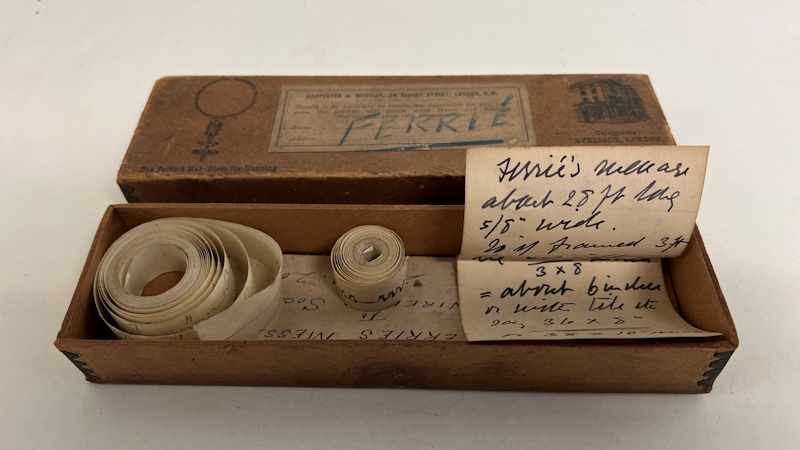The pioneering genius of Alan Archibald Campbell Swinton FRS can be seen in a recently catalogued archival collection of his personal and professional papers, as Vida Milovanovic reveals.
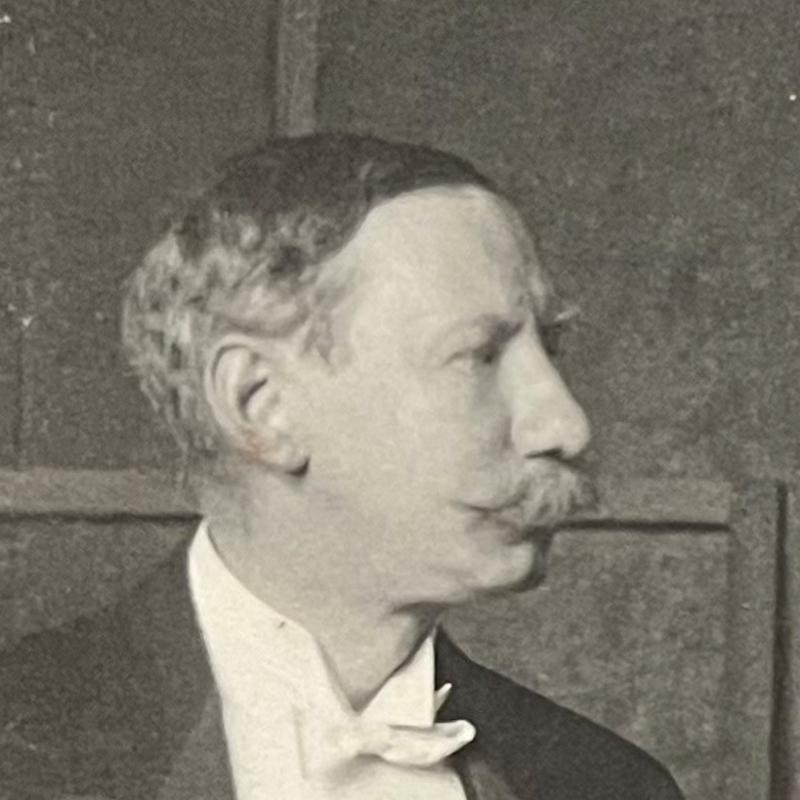
As well as devising the theoretical foundation for television twenty years before its practical implementation, Alan Archibald Campbell Swinton FRS (1863-1930) was a man of many other technical achievements. He was the first in England to take a photograph by X-rays, he aided in the trials of the steam yacht Turbinia, and he utilised lead-covered cables for electric wiring in ships. This array of practical engineering and experimentation added to my enthusiasm when exploring and cataloguing his papers.
 Portrait of Alan Archibald Campbell Swinton (ACS/6/1/50)
Portrait of Alan Archibald Campbell Swinton (ACS/6/1/50)
The collection reflects Swinton’s personality, and his range of scientific pursuits and creative endeavours. It includes several thousand letters, featuring technical discussions with William Armstrong FRS, William Crookes FRS and Lord Kelvin FRS, exchanges with scientific institutions and businesses, and correspondence with personal friends such as Randall Thomas Davidson (1848-1930), Archbishop of Canterbury.
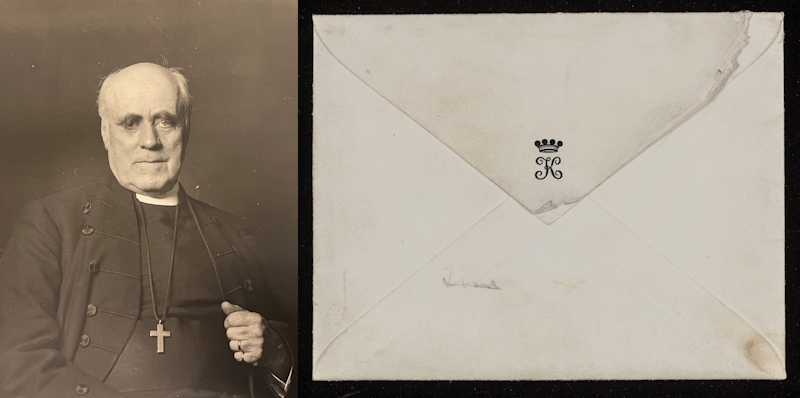 Portrait of Randall Thomas Davidson taken by Swinton (ACS/6/1/55/5), and envelope featuring the monogram of Lord Kelvin (ACS/1/1/202)
Portrait of Randall Thomas Davidson taken by Swinton (ACS/6/1/55/5), and envelope featuring the monogram of Lord Kelvin (ACS/1/1/202)
Swinton kept in close contact with William Armstrong, to whom he was apprenticed in 1882 at the engineering works of Armstrong, Mitchell & Company (later Armstrong Whitworth) in Elswick, Newcastle upon Tyne. Swinton frequently obtained apparatus for Armstrong and would visit him at his home in Cragside, Northumberland. The letters, dating to the late 1890s, document these interactions, and cover Armstrong's efforts to produce high-tension electric discharges from induction coils connected in series, in addition to his attempts to turn a boiler into a hydro-electric machine. The boiler required insulating legs, which Swinton obtained.
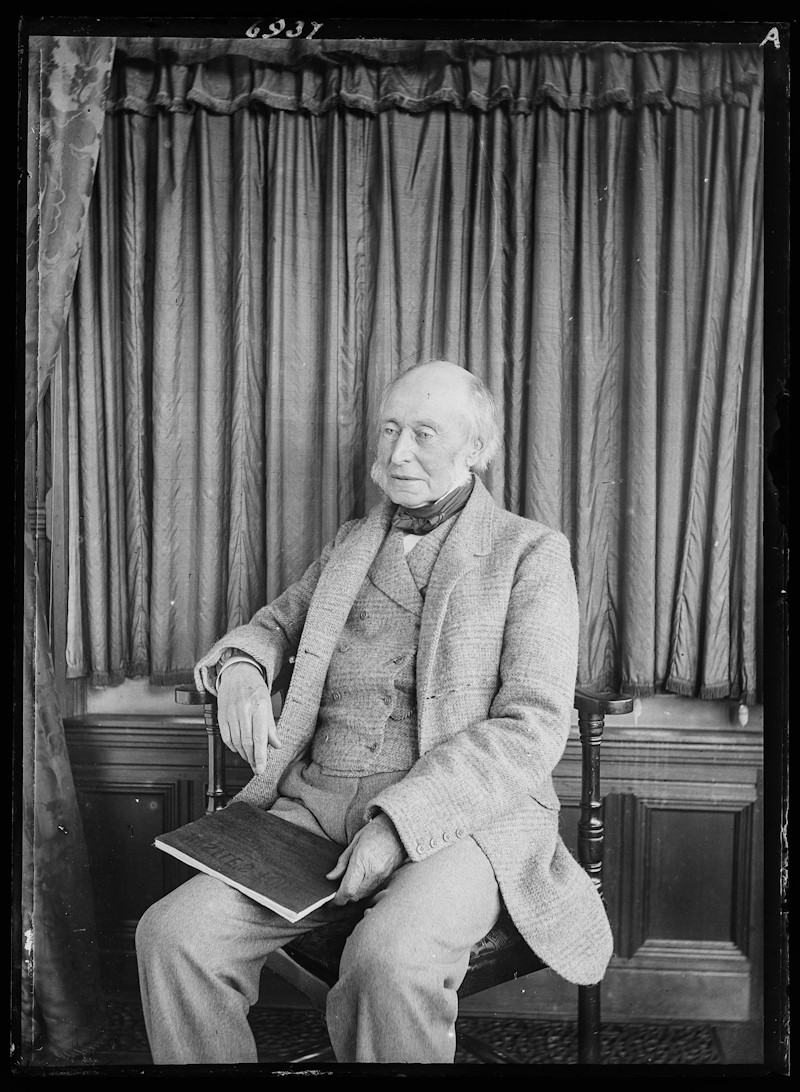 Portrait of William Armstrong, taken by Swinton (ACS/6/2/2/34)
Portrait of William Armstrong, taken by Swinton (ACS/6/2/2/34)
William Crookes advised Swinton on his book The principles and practice of electric lighting (1884), and supported his application for membership of the Society of Telegraph Engineers. They exchanged scientific ideas on the phosphorescence of alumina, discussed experiments on vacuum tubes actuated by a battery, and loaned each other apparatus such as the Wehnelt-Caldwell Interrupter and old historical lamps.
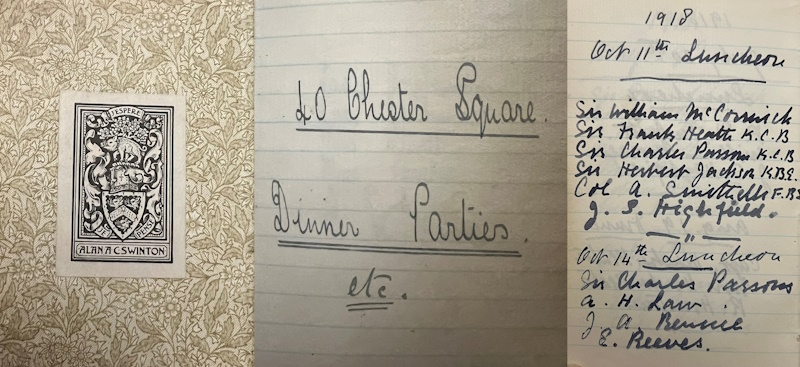 Diary of dinner parties (ACS/2/4)
Diary of dinner parties (ACS/2/4)
Swinton’s professional relationships with other eminent scientists of the period were also personal. A charming leather-bound diary lists the guests at dinner parties hosted by Swinton in his London home, 40 Chester Square, between 1909 and 1928. Swinton habitually documented these convivial occasions by taking beautiful group portraits.
 Standing, L-R: Swinton, George Elphinstone, Sidney Brown FRS, George Forbes FRS; sitting, L-R: Major Percy MacMahon FRS, Peder Pedersen, Sir William Crookes FRS (RS.11158)
Standing, L-R: Swinton, George Elphinstone, Sidney Brown FRS, George Forbes FRS; sitting, L-R: Major Percy MacMahon FRS, Peder Pedersen, Sir William Crookes FRS (RS.11158)
Swinton was close to his sisters, Alice Susan Lucy and Catherine Margaret Campbell Swinton. In letters to them, he discussed his scientific pursuits and offered personal accounts of historical events, such as the celebrations of the wedding of Prince George and Princess Victoria Mary in 1893, and the First World War naval raid on Scarborough, Hartlepool and Whitby on 16 December 1914. Swinton described how the bombardment of his Scarborough Electric Supply Company during the raid killed his secretary, John Hall, and wounded his chief cashier. He explained that the likely objective was to destroy his works and wireless station, but the attack proved unsuccessful as his equipment suffered little damage (ACS/1/2/6/7).
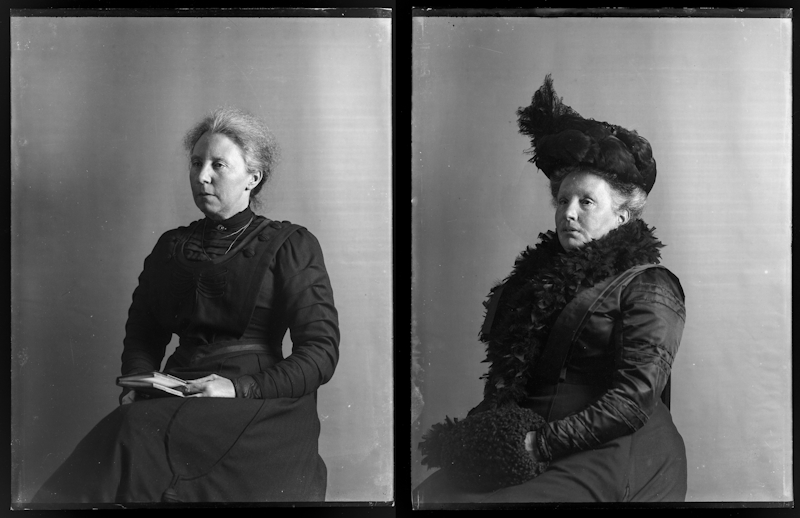 Alice Susan Lucy Campbell Swinton (ACS/6/2/2/42) and Kate Margaret Campbell Swinton (ACS/6/2/2/36)
Alice Susan Lucy Campbell Swinton (ACS/6/2/2/42) and Kate Margaret Campbell Swinton (ACS/6/2/2/36)
An avid photographer from childhood, Swinton produced countryside landscapes and portraits of friends and family, as well as attempting to capture electrical phenomena. His X-ray images of his own hand, plus those of Crookes, Armstrong and Kelvin, were exhibited at the Royal Society Conversazione on 6 May 1896 and are particularly fascinating, but they were not his only scientific trial.
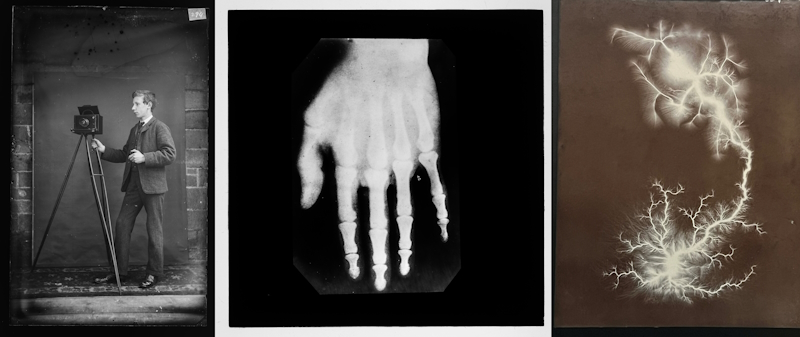 Young Swinton experimenting with photography (ACS/6/2/2/3); X-ray photograph of Swinton’s own hand, 1896 (ACS/6/2/4/3); oscillatory discharge from positive to negative (ACS/6/1/6)
Young Swinton experimenting with photography (ACS/6/2/2/3); X-ray photograph of Swinton’s own hand, 1896 (ACS/6/2/4/3); oscillatory discharge from positive to negative (ACS/6/1/6)
Within an old box for spectacles, Swinton retained two reels of coded messages, along with a decoded transcript. These were from a demonstration with the radio pioneer General Gustave-Auguste Ferrié, in which printed signals were sent from Paris to London via wireless telegraphy:
In 1908, Swinton proposed the use of cathode ray tubes for the transmission and display of pictures, demonstrating the idea to the Röntgen Society in 1911. This provided the theoretical basis for television, but he failed to patent the idea. He was an outspoken opponent of the limiting mechanical televisual equipment of the Baird Company, and advocated for the development of an all-electrical system. Owing to lack of funding, inadequate research facilities and subsequent progress by others in the field, Swinton’s work was overlooked and initially forgotten.
Posthumous efforts were made to recognise Swinton's contribution to the development of television, by individuals such as Thornton Howard Bridgewater, who produced a monograph on Swinton and was instrumental in the creation of a commemorative plaque in Edinburgh (ACS/4/10).
 This angelic rendition of Swinton commemorates his election to the Royal Society in 1915, in the style of a cartoon of Benjamin Disraeli which appeared in Punch magazine in February 1874 (ACS/2/9/11)
This angelic rendition of Swinton commemorates his election to the Royal Society in 1915, in the style of a cartoon of Benjamin Disraeli which appeared in Punch magazine in February 1874 (ACS/2/9/11)
Working on the Swinton collection over the past six months has given me a rare insight into the life and work of a pioneering, yet unsung, hero of electrical engineering. It has been a pleasure and privilege to immerse myself in the world of such an interesting and creative man, and I hope the revelation of his papers will help to shine a brighter light on his genius.

